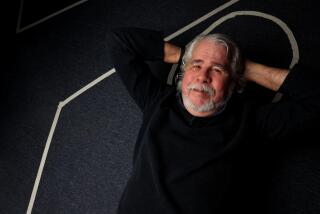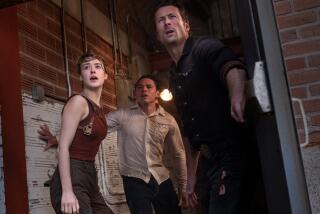Longtime Fans Gather for Final Act in Theater’s 62-Year Run
The Whittier Theatre completed its 62-year run last week, and the last show was a smash. Wrecking cranes, bulldozers and jackhammers clawed, rammed, vibrated and chewed the landmark theater into rubble and splinters.
At any given moment, as many as 30 people watched the goings-on from across the street, in McNees Park, a patch of green between Hadley Street and Whittier Boulevard.
Most spectators had been longtime theater patrons. They could not believe the theater was coming down as they watched--mesmerized--from under the park’s blooming jacarandas.
“This is it. This is the final blow,” said carpenter Pete Petersen, a 23-year Whittier resident who looked on with his wife, Betty. “We used to go to shows here when we first moved here.”
Shirley Boranian, 59, joined the bystanders at one point. “I should be home cooking and sewing, but you could feel the battering ram hitting it, and I felt like you gotta go check this out,” she said.
The crash of the crane’s clamshell-shaped claw into the building made her words hard to hear.
A four-year struggle to save the theater ended early last week when the City Council rejected owner Peter Doerken’s $1.3-million asking price. City staff said buying the theater was too risky without a plan to restore the old movie house, city sources said.
On July 3, Doerken ordered the demolition to proceed. The electric hum of the wrecking crane signaled the start of the theater’s last act.
Some stopped to watch and some filed by, like mourners at a funeral parlor.
Charlie Marlatt, 72, was one who stopped by to say so long. Marlatt, who managed the theater from 1945 to 1954, arrived with two 35-millimeter cameras around his neck and tales from the past.
In 1946, Marlatt asked his doorman, Walt, if he knew any nice girls. Walt brought over sister-in-law, Shirley. Four weeks later, Marlatt married her, and they’re still together.
Marlatt managed the theater for $65 a week, when the admission was 60 cents for adults and 14 cents for children. He lived in the tiny apartment above the theater until 1952.
One of his jobs was crawling under the roof and changing bulbs in the theater’s famous suspended ceiling. It featured a simulated night sky with pinpoints of light in recognizable constellations. A cloud machine added to the outdoor effect.
That once-glorious special effect was on the minds of passersby as they saw the theater roof come crashing down.
“The ceiling was beautiful,” Joe Villegas said as he watched with his wife, Lupe. “White, fluffy clouds and stars. It was so relaxing.”
The interior side walls supported a plaster-and-wire recreation of a hacienda patio--complete with balconies, tile roof overhangs, art-stone window grilles, arched doors, pillars, towers, turrets and chimneys.
During the theater’s heyday, ushers in red coats and red slacks monitored the four aisles. They allowed no food inside.
One former employee took time off from his job as a forklift salesman to observe the demolition. Glenn Niceley, 62, worked as a doorman at the theater while in high school. “Those were the years,” Niceley said. “They knew what entertainment was. The Whittier Theatre was the place to go. It was the nicest of all the theaters in the area.
“I’m kind of witnessing the death of a bygone era. I guess they call it progress,” he said.
The theater opened with all the fanfare of a Hollywood gala July 31, 1929. Opening night featured three vaudeville acts and celebrities such as actor Monte Blue, who appeared in the first movie: “From Headquarters.”
Blue told the mayor and more than 1,000 onlookers that sound film was here to stay. But in case he was wrong, the builders had constructed a loft for an organ to accompany silent films. Behind the screen was a full-size hardwood stage with a drop loft above and dressing rooms beneath.
The theater’s 79-foot tower dominated a countryside of farms and offered a view to the sea in the days before smog and freeways.
The tower came down minutes after general demolition began.
Doerken’s representative gave the order to start smashing almost four years after the developer bought the theater.
The 982-seat house had become a dinosaur in the era of television and multiscreen cineplexes. The theater tried to stay in business as a dollar movie house and by screening Spanish-language films. It finally closed in 1986, about a year before Doerken bought it.
The developer originally said he planned to renovate the theater, but soon declared the renovation unfeasible. He announced plans to tear down the structure and build a shopping center, angering many residents.
Like the hero in any dozen movies that once played there, the theater seemed to endure all blows.
When the Oct. 1, 1987, earthquake damaged the theater, the city issued Doerken an emergency demolition permit. That demolition was halted when the Whittier Conservancy, a preservation group, obtained a court injunction.
The court cleared demolition to resume by March, 1990. A delay ensued over a dispute about theater artifacts, and then the state Office of Historic Preservation halted demolition under a law protecting landmarks damaged in earthquakes. When a demolition crew began working at the site last September in violation of the state order, city officials ordered the workers to stop. At the time, plans to convert the building into a restaurant seemed promising.
But the state dropped its demolition ban after the developer filed suit. The restaurant scheme failed, along with the city’s last-ditch efforts to buy the property.
Doerken would have gladly unloaded the building had anyone offered a remotely reasonable price, attorney Charles Cummings said.
Doerken has no immediate plans for the site, the attorney said.
Even former theater patrons agreed that the theater had become an eyesore.
“It kind of turns people off coming into the city,” onlooker Petersen said.
But he was sorry the theater could not be saved, as was former house manager Marlatt.
“It’s kind of a sad day,” Marlatt said. “The kids going to the theater now, they don’t know the experience of what it was to see a movie in this kind of theater.”
Nick Rodriguez and Paul Ta, both 13, have their own memories of the theater. Once the reels stopped turning, the old structure was a place to sneak into, explore, collect strips of film and catch pigeons.
They stumbled onto homeless people sleeping under the stage and in Marlatt’s old apartment, and they climbed the wood-and-stucco tower, made rickety by termites.
They and their friends can lay claim to being the only recent theater renovators. Over the last four years, they secretly nailed supports to the tower’s loose boards and ladders to keep it standing.
“Everyone’s going to miss this place,” Paul said. “Now, we have to find a new place to play.”
More to Read
The biggest entertainment stories
Get our big stories about Hollywood, film, television, music, arts, culture and more right in your inbox as soon as they publish.
You may occasionally receive promotional content from the Los Angeles Times.











